Abstract
Serum and cervicovaginal mucus (CVM) antibodies from heifers after genital infection or systemic immunization with Campylobacter (Vibrio) fetus were classified according to their immunoglobulin class, antigenic specificities, and biological functions. Only immunoglobulin (Ig) A antibodies, specific both for O and superficial, heat-labile, whole-cell (W) antigens, were detected in CVM of convalescent animals. After systemic immunization, antibodies in serum were directed principally to W antigens and were located in IgG1, IgG2, and IgM classes; CVM antibodies of the same specificity were detected only in the IgG subclasses. Functional tests revealed that antibodies of W specificity, whether of the IgA or IgG class, were capable of immobilizing the organism. However, IgG antibodies immobilized with clumping, whereas IgA antibodies immobilized single organisms within the 3-min period. None of the antibody preparations was bactericidal in the presence of homologous complement when the infecting strain was used as the target organism, but a bactericidal effect was observed when the target strain was rough and non-encapsulated. Both serum and CVM from systemically immunized animals opsonized C. fetus organisms, but CVM from locally immunized animals containing IgA antibodies was not opsonic. It is hypothesized that functions of immobilization for IgA and IgG and of opsonization for IgG are important features of protective immunity in venereal vibriosis.
Full text
PDF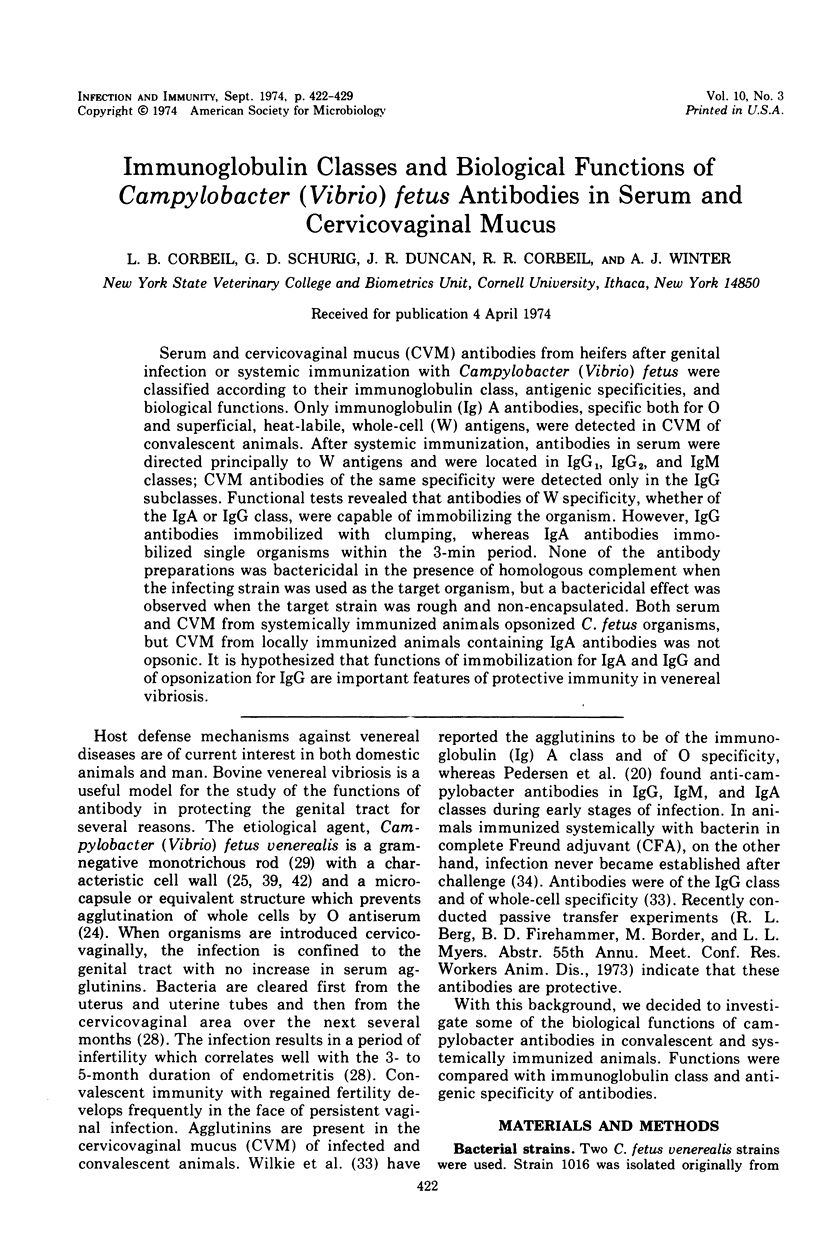
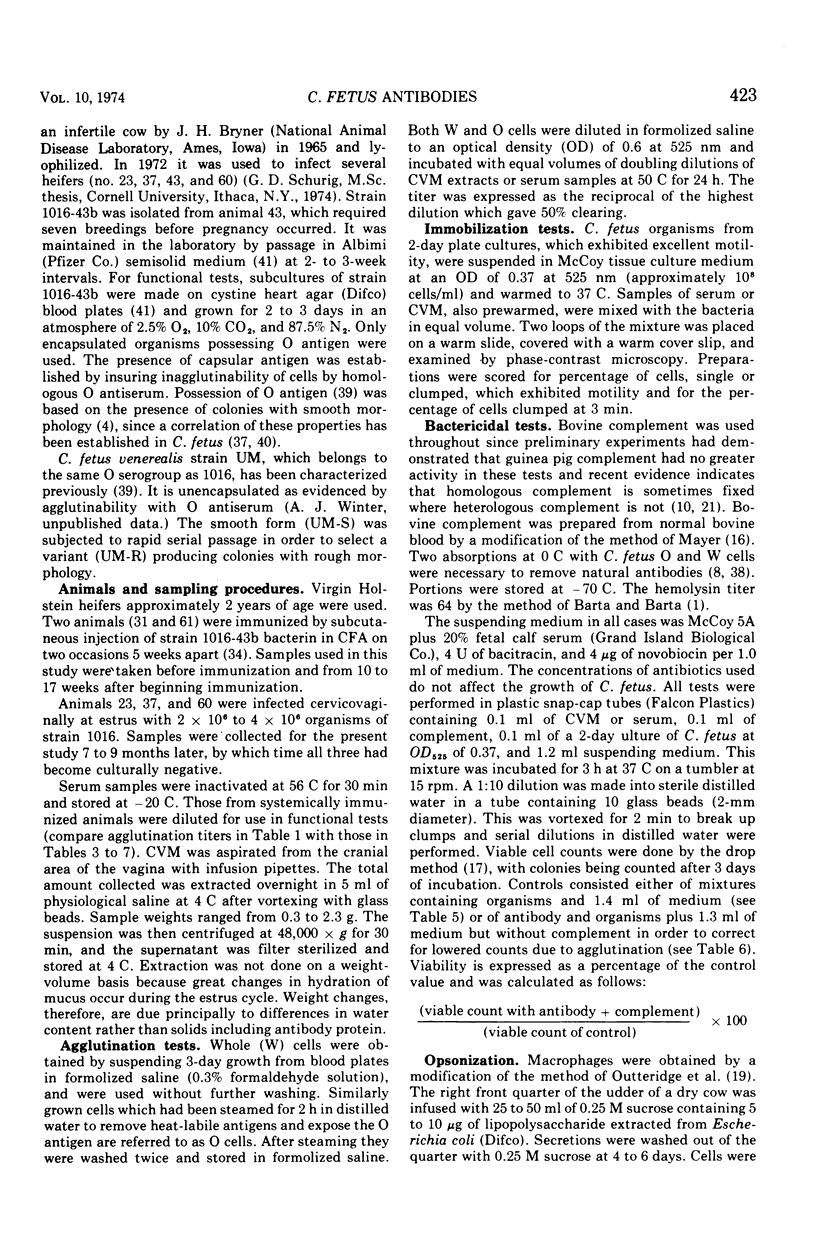
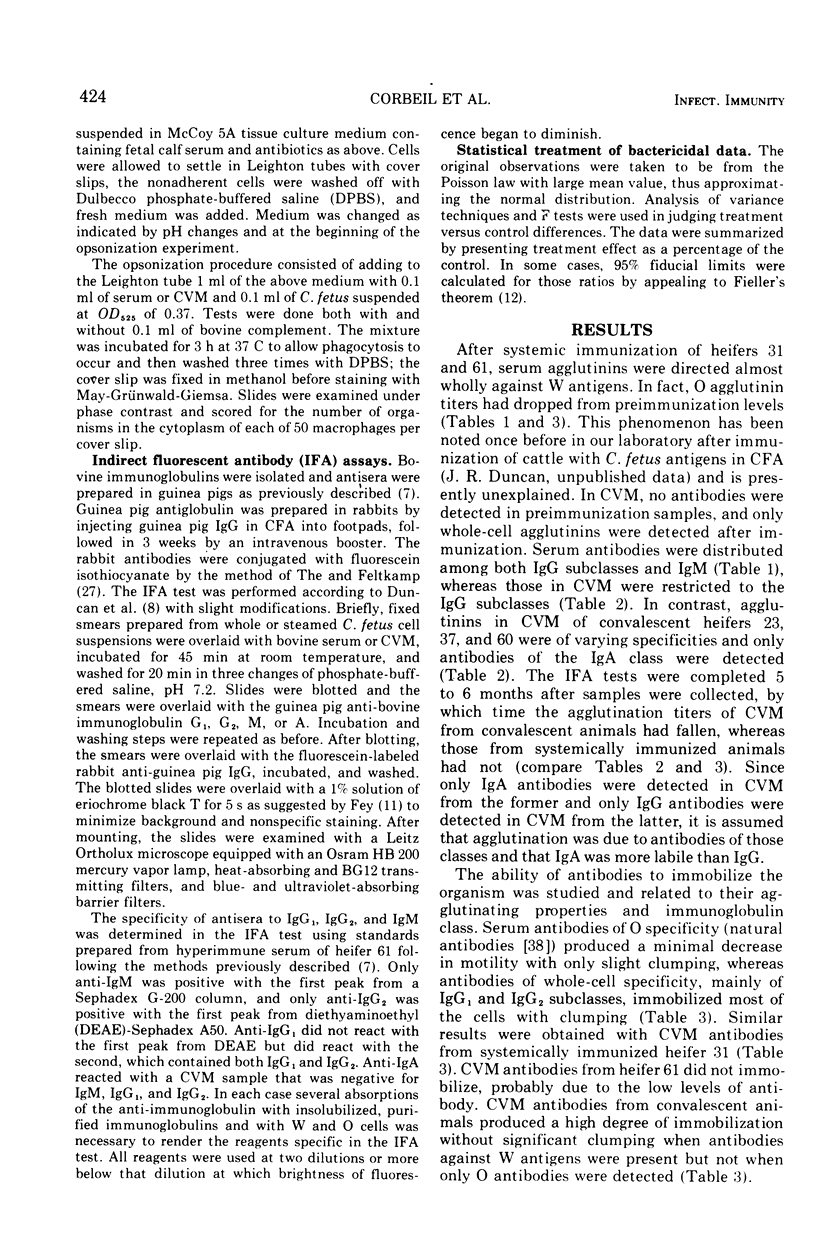
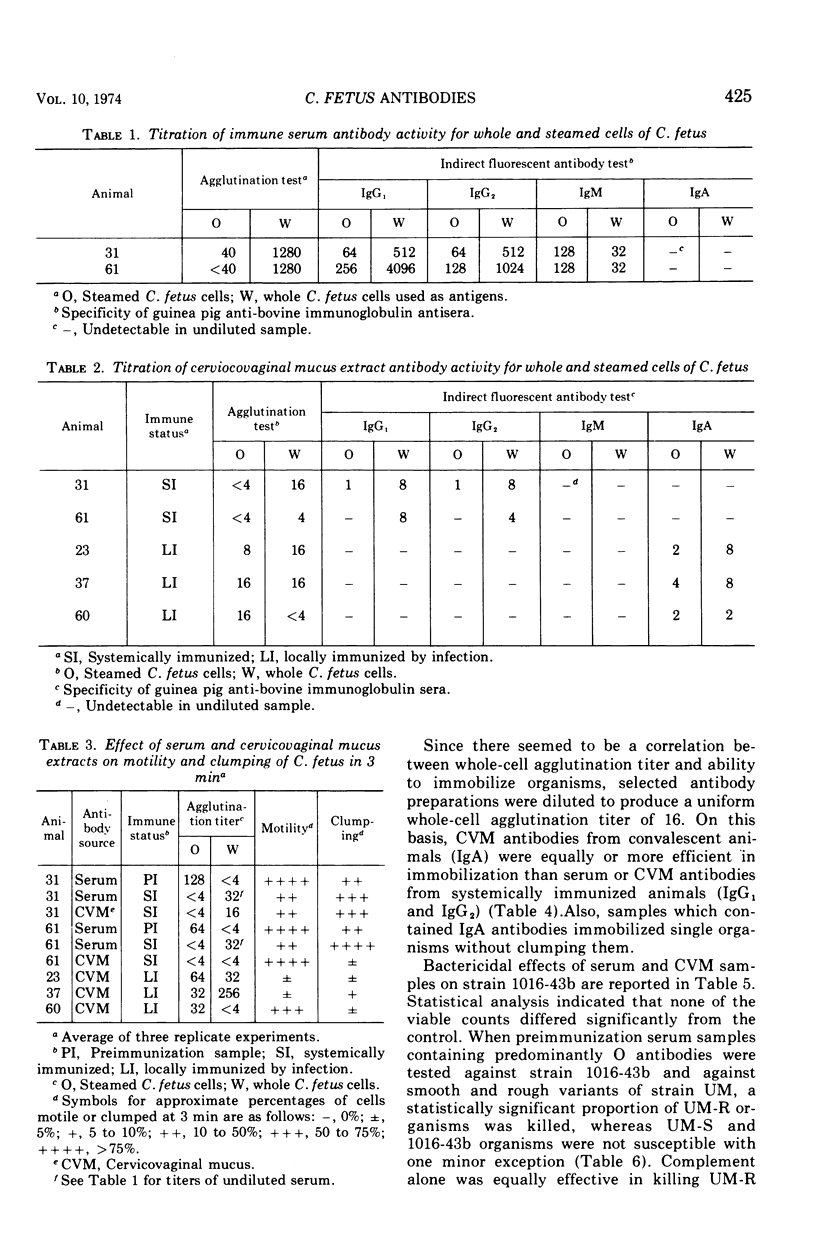
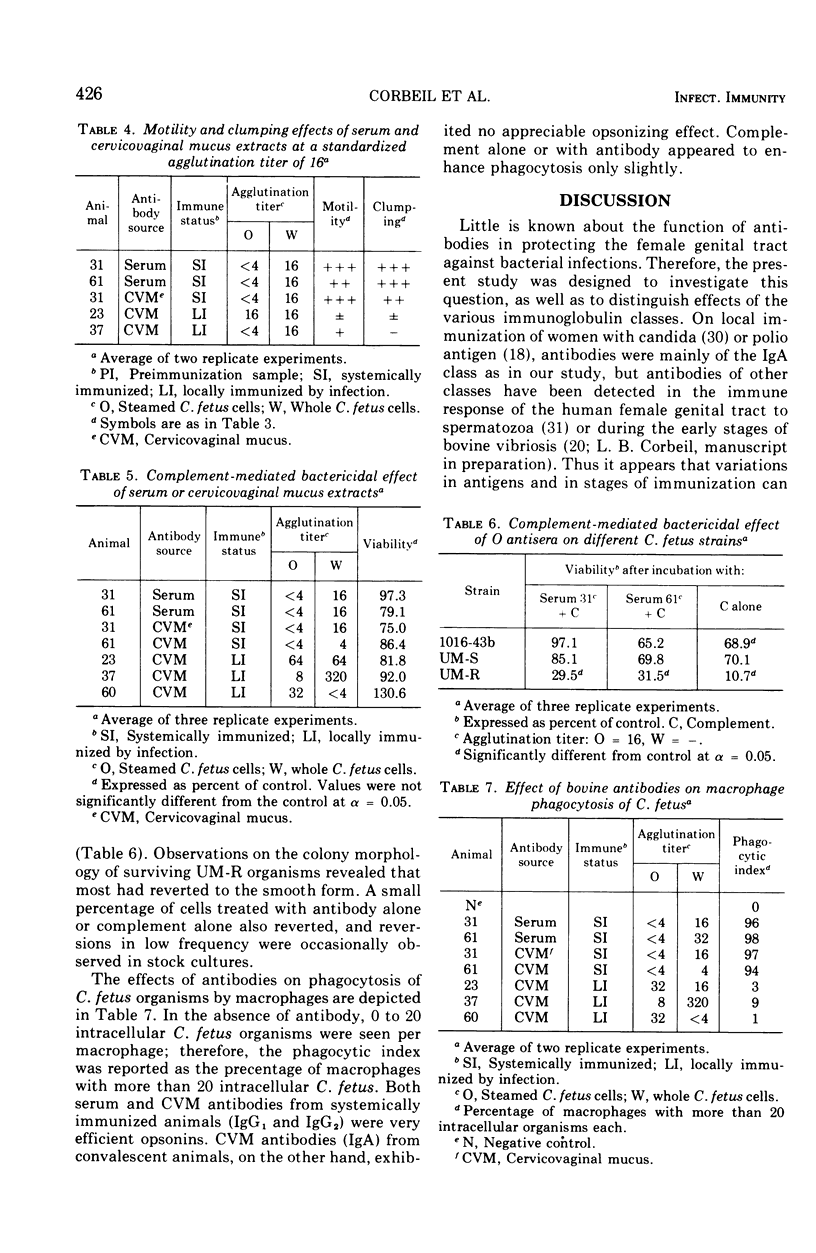
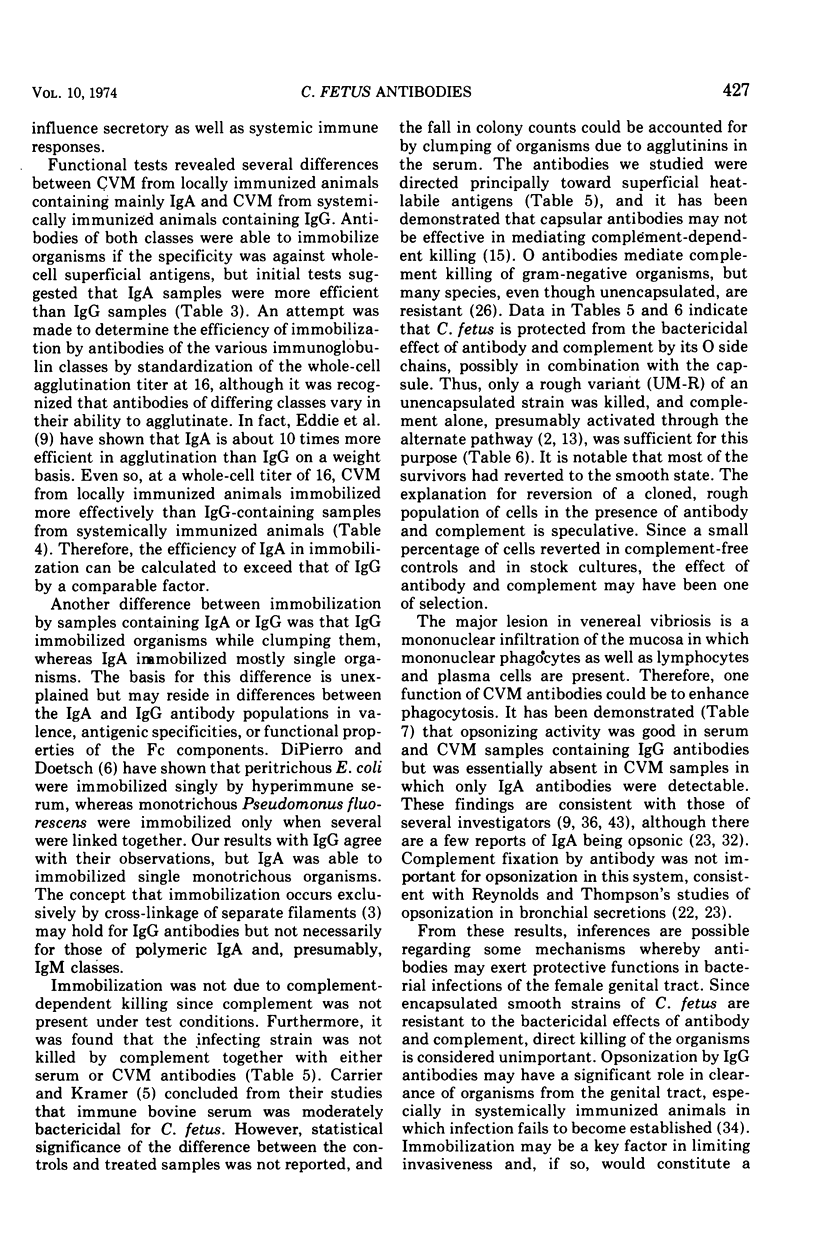
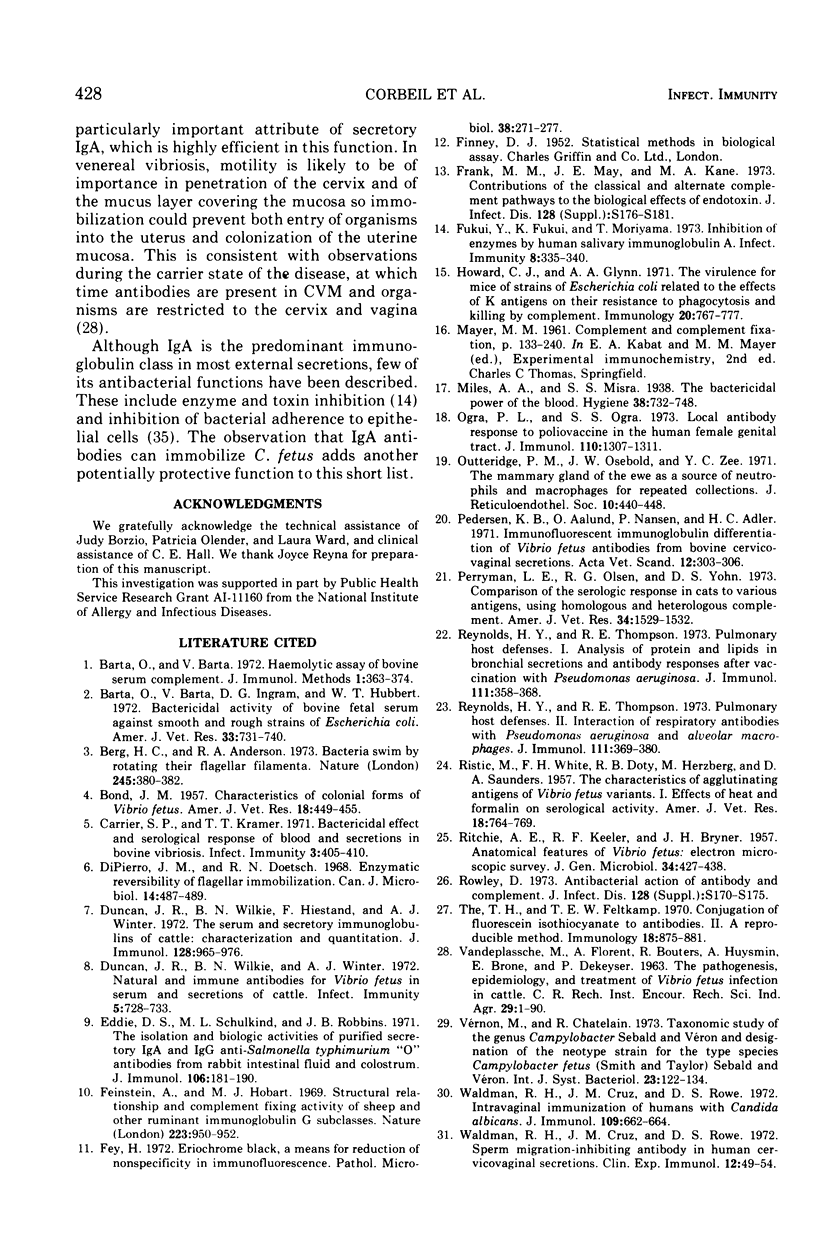
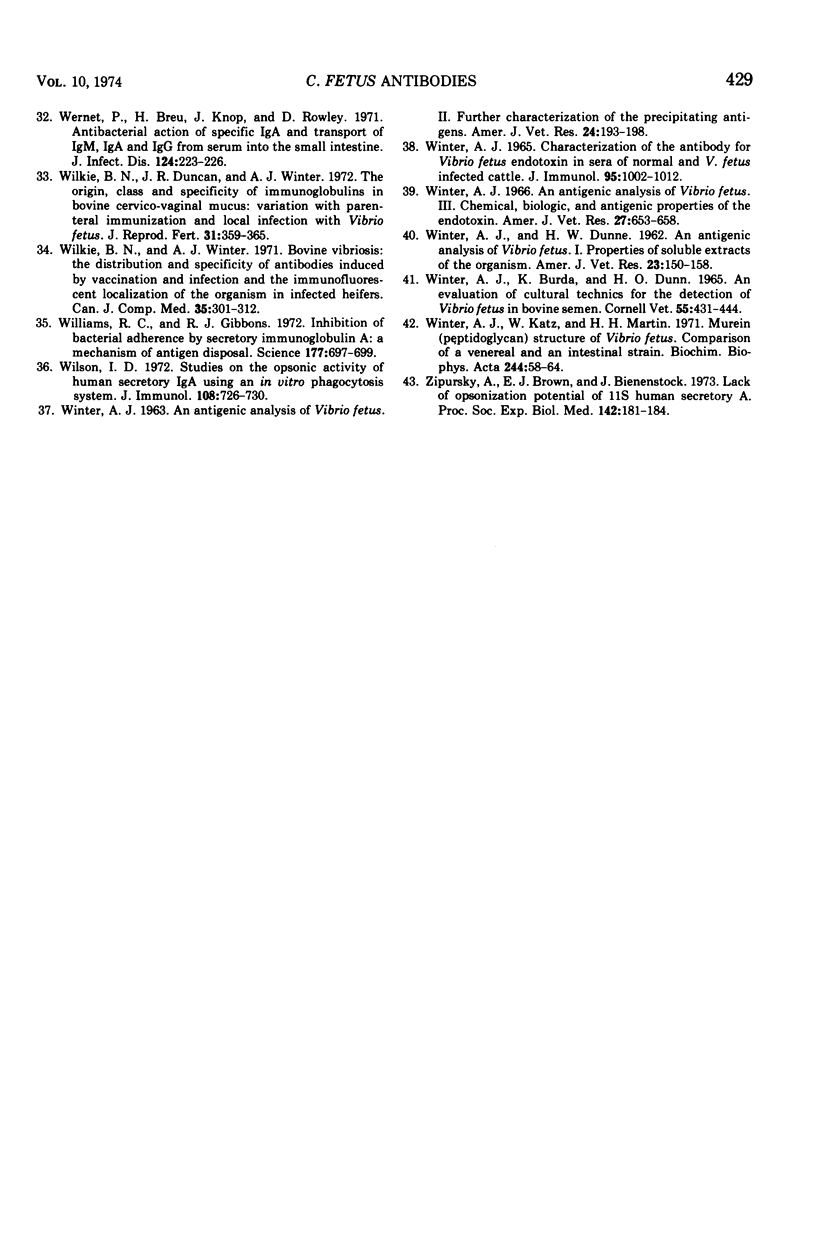
Selected References
These references are in PubMed. This may not be the complete list of references from this article.
- BOND J. M. Characteristics of colonial forms of Vibrio fetus. Am J Vet Res. 1957 Apr;18(67):449–455. [PubMed] [Google Scholar]
- Barta O., Barta V. Haemolytic assay of bovine serum complement. J Immunol Methods. 1972 Aug;1(4):363–374. doi: 10.1016/0022-1759(72)90029-4. [DOI] [PubMed] [Google Scholar]
- Barta O., Barta V., Ingram D. G., Hubbert W. T. Bactericidal activity of bovine fetal serum against smooth and rough strains of Escherichia coli. Am J Vet Res. 1972 Apr;33(4):731–740. [PubMed] [Google Scholar]
- Berg H. C., Anderson R. A. Bacteria swim by rotating their flagellar filaments. Nature. 1973 Oct 19;245(5425):380–382. doi: 10.1038/245380a0. [DOI] [PubMed] [Google Scholar]
- Carrier S. P., Kramer T. T. Bactericidal effect and serological response of blood and secretions in bovine vibriosis. Infect Immun. 1971 Mar;3(3):405–410. doi: 10.1128/iai.3.3.405-410.1971. [DOI] [PMC free article] [PubMed] [Google Scholar]
- DiPierro J. M., Doetsch R. N. Enzymatic reversibility of flagellar immobilization. Can J Microbiol. 1968 Apr;14(4):487–489. doi: 10.1139/m68-081. [DOI] [PubMed] [Google Scholar]
- Duncan J. R., Wilkie B. N., Hiestand F., Winter A. J. The serum and secretory immunoglobulins of cattle: characterization and quantitation. J Immunol. 1972 Apr;108(4):965–976. [PubMed] [Google Scholar]
- Duncan J. R., Wilkie B. N., Winter A. J. Natural and immune antibodies for Vibrio fetus in serum and secretions of cattle. Infect Immun. 1972 May;5(5):728–733. doi: 10.1128/iai.5.5.728-733.1972. [DOI] [PMC free article] [PubMed] [Google Scholar]
- Eddie D. S., Schulkind M. L., Robbins J. B. The isolation and biologic activities of purified secretory IgA and IgG anti-Salmonella typhimurium "O" antibodies from rabbit intestinal fluid and colostrum. J Immunol. 1971 Jan;106(1):181–190. [PubMed] [Google Scholar]
- Feinstein A., Hobart M. J. Structural relationship and complement fixing activity of sheep and other ruminant immunoglobulin G subclasses. Nature. 1969 Aug 30;223(5209):950–952. doi: 10.1038/223950a0. [DOI] [PubMed] [Google Scholar]
- Fey H. Eriochrome black, a means for reduction of nonspecificity in immunofluorescence. Pathol Microbiol (Basel) 1972;38(4):271–277. doi: 10.1159/000162418. [DOI] [PubMed] [Google Scholar]
- Fukui Y., Fukui K., Moriyama T. Inhibition of enzymes by human salivary immunoglobulin A. Infect Immun. 1973 Sep;8(3):335–340. doi: 10.1128/iai.8.3.335-340.1973. [DOI] [PMC free article] [PubMed] [Google Scholar]
- Howard C. J., Glynn A. A. The virulence for mice of strains of Escherichia coli related to the effects of K antigens on their resistance to phagocytosis and killing by complement. Immunology. 1971 May;20(5):767–777. [PMC free article] [PubMed] [Google Scholar]
- Ogra P. L., Ogra S. S. Local antibody response to poliovaccine in the human female genital tract. J Immunol. 1973 May;110(5):1307–1311. [PubMed] [Google Scholar]
- Outteridge P. M., Osebold J. W., Zee Y. C. The mammary gland of the ewe as a source of neutrophils and macrophages for repeated collections. J Reticuloendothel Soc. 1971 Nov;10(5):440–448. [PubMed] [Google Scholar]
- Pedersen K. B., Aalund O., Nansen P., Adler H. C. Immunofluorescent immunoglobulin differentiation of vibrio fetus antibodies from bovine cervico-vaginal secretions. Acta Vet Scand. 1971;12(2):303–306. doi: 10.1186/BF03547763. [DOI] [PMC free article] [PubMed] [Google Scholar]
- Perryman L. E., Olsen R. G., Yohn D. S. Comparison of the serologic response in cats to various antigens, using homologous and heterologous complement. Am J Vet Res. 1973 Dec;34(12):1529–1532. [PubMed] [Google Scholar]
- RISTIC M., WHITE F. H., DOTY R. B., HERZBERG M., SANDERS D. A. The characteristics of agglutinating antigens of Vibrio fetus variants. I. Effects of heat and formalin on serological activity. Am J Vet Res. 1957 Oct;18(69):764–770. [PubMed] [Google Scholar]
- Reynolds H. Y., Thompson R. E. Pulmonary host defenses. I. Analysis of protein and lipids in bronchial secretions and antibody responses after vaccination with pseudomonas aeruginosa. J Immunol. 1973 Aug;111(2):358–368. [PubMed] [Google Scholar]
- Reynolds H. Y., Thompson R. E. Pulmonary host defenses. II. Interaction of respiratory antibodies with Pseudomonas aeruginosa and alveolar macrophages. J Immunol. 1973 Aug;111(2):369–380. [PubMed] [Google Scholar]
- The T. H., Feltkamp T. E. Conjugation of fluorescein isothiocyanate to antibodies. II. A reproducible method. Immunology. 1970 Jun;18(6):875–881. [PMC free article] [PubMed] [Google Scholar]
- WINTER A. J. An antigenic analysis of Vibrio fetus. II. Further characterization of the precipitating antigens. Am J Vet Res. 1963 Jan;24:193–198. [PubMed] [Google Scholar]
- WINTER A. J., BURDA K., DUNN H. O. AN EVALUATION OF CULTURAL TECHNICS FOR THE DETECTION OF VIBRIO FETUS IN BOVINE SEMEN. Cornell Vet. 1965 Jul;55:431–444. [PubMed] [Google Scholar]
- WINTER A. J., DUNNE H. W. An antigenic analysis of Vibrio fetus. I. Properties of soluble extracts of the organism. Am J Vet Res. 1962 Jan;23:150–158. [PubMed] [Google Scholar]
- Waldman R. H., Cruz J. M., Rowe D. S. Intravaginal immunization of humans with Candida albicans. J Immunol. 1972 Oct;109(4):662–664. [PubMed] [Google Scholar]
- Waldman R. H., Cruz J. M., Rowe D. S. Sperm migration-inhibiting antibody in human cervicovaginal secretions. Clin Exp Immunol. 1972 Sep;12(1):49–54. [PMC free article] [PubMed] [Google Scholar]
- Wernet P., Breu H., Knop J., Rowley D. Antibacterial action of specific IgA and transport of IgM, IgA, and IgG from serum into the small intestine. J Infect Dis. 1971 Aug;124(2):223–226. doi: 10.1093/infdis/124.2.223. [DOI] [PubMed] [Google Scholar]
- Wilkie B. N., Duncan J. R., Winter A. J. The origin, class and specificity of immunoglobulins in bovine cervico-vaginal mucus: variation with parenteral immunization and local infection with Vibrio fetus. J Reprod Fertil. 1972 Dec;31(3):359–365. doi: 10.1530/jrf.0.0310359. [DOI] [PubMed] [Google Scholar]
- Wilkie B. N., Winter A. J. Bovine vibriosis: the distribution and specificity of antibodies induced by vaccination and infection and the immunofluorescent localization of the organism in infected heifers. Can J Comp Med. 1971 Oct;35(4):301–312. [PMC free article] [PubMed] [Google Scholar]
- Williams R. C., Gibbons R. J. Inhibition of bacterial adherence by secretory immunoglobulin A: a mechanism of antigen disposal. Science. 1972 Aug 25;177(4050):697–699. doi: 10.1126/science.177.4050.697. [DOI] [PubMed] [Google Scholar]
- Wilson I. D. Studies on the opsonic activity of human secretory IgA using an in vitro phagocytosis system. J Immunol. 1972 Mar;108(3):726–730. [PubMed] [Google Scholar]
- Winter A. J. An antigenic analysis of Vibrio fetus. 3. Chemical, biologic, and antigenic properties of the endotoxin. Am J Vet Res. 1966 May;27(118):653–658. [PubMed] [Google Scholar]
- Winter A. J. Characterization of the antibody for Vibrio fetus endotoxin in sera of normal and V. fetus infected cattle. J Immunol. 1965 Dec;95(6):1002–1012. [PubMed] [Google Scholar]
- Winter A. J., Katz W., Martin H. H. Murein (peptidoglycan) structure of Vibrio fetus. Comparison of a venereal and an intestinal strain. Biochim Biophys Acta. 1971 Jul 20;244(1):58–64. doi: 10.1016/0304-4165(71)90120-6. [DOI] [PubMed] [Google Scholar]
- Zipursky A., Brown E. J., Bienenstock J. Lack of opsonization potential of 11S human secretory A. Proc Soc Exp Biol Med. 1973 Jan;142(1):181–184. doi: 10.3181/00379727-142-36983. [DOI] [PubMed] [Google Scholar]


